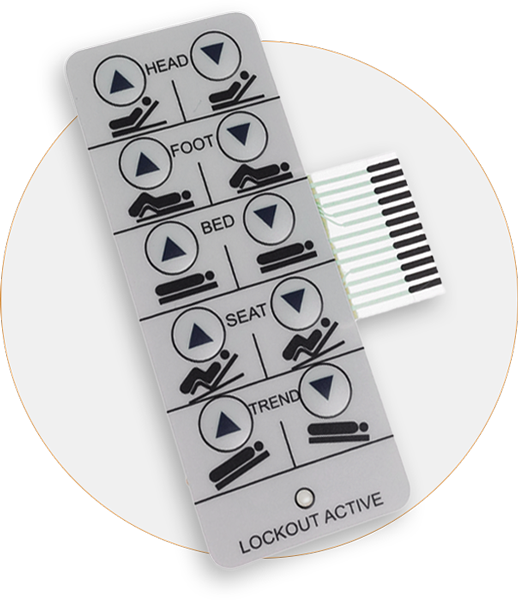How Membrane Switches Over Add To the Sturdiness of Electronic Control Panels
Membrane layer switches play a vital role in enhancing the toughness of digital control panels, largely through their multi-layered building which supplies reliable defense versus ecological factors such as moisture and dust. The lack of relocating parts significantly lowers the probability of mechanical failures, making membrane layer changes perfect for requiring applications.
Definition of Membrane Layer Switches

Membrane buttons are developed to be thin and lightweight, making them suitable for applications where room is restricted. They can be produced in various shapes, dimensions, and shades, providing versatility in style that satisfies visual and useful needs. Additionally, membrane layer switches can integrate various technologies, such as responsive comments and LED indications, improving user experience.
As a result of their construction, membrane buttons are often resistant to dust, moisture, and basic wear, adding to their sturdiness in demanding atmospheres. Their seamless layout not just promotes very easy cleaning yet additionally decreases the risk of mechanical failing, making them a recommended choice for manufacturers looking for dependable customer interfaces in their electronic control panels.
Protection Versus Environmental Variables
The layout of membrane switches naturally gives a level of protection against various ecological factors, which is vital for preserving performance in challenging problems - Membrane Switch. These switches are commonly constructed with layers of flexible products that protect interior parts from moisture, dirt, and pollutants. By encapsulating the wiring, membrane changes lessen the threat of brief circuits and rust, which can considerably harm efficiency
In addition, using robust adhesives and sealers throughout manufacturing boosts their resistance to ecological difficulties. Membrane buttons can endure exposure to chemicals and solvents, making them suitable for industries such as food handling and healthcare, where hygiene and tidiness are extremely important. Their smooth surface design also avoids the accumulation of dirt and bacteria, facilitating simpler cleansing and upkeep.
Temperature changes are one more ecological concern, and membrane buttons are engineered to function efficiently throughout a large array of temperatures (Membrane Switch). This adaptability makes sure that control panels continue to be operational in various setups, from commercial atmospheres to customer electronic devices
Influence on Customer Interaction
Customer communication with electronic control board is substantially affected by the style and functionality of membrane switches. These buttons provide a tactile interface that boosts the total customer experience, allowing for user-friendly navigation and control. Their receptive nature guarantees that users obtain prompt comments upon activation, which is vital for tasks calling for precision and performance.
Additionally, the smooth surface area of membrane layer switches promotes very easy cleansing and upkeep, advertising customer confidence in the integrity of the user interface. This tidiness is particularly vital in environments where health is paramount, such as clinical or food processing settings. In addition, the small and light-weight layout of membrane switches contributes to the visual allure of control board, encouraging individual interaction with a modern and smooth look.
Moreover, the integration of aesthetic elements, such as published icons and backlighting, assists users swiftly identify functions, reducing the learning contour linked with brand-new equipment. Therefore, customers can operate tools extra successfully, leading to increased find more information efficiency and fulfillment. In recap, membrane buttons play a crucial duty in boosting individual interaction by incorporating capability, aesthetics, and convenience of usage, ultimately resulting in enhanced operational effectiveness.
Style Flexibility and Customization
Layout flexibility and customization are necessary facets of membrane buttons, making it possible for suppliers to customize digital control board to certain applications and customer requirements. This versatility permits the assimilation of numerous style elements, such as colors, graphics, and appearances, which can boost the aesthetic allure and user interaction of the control board.
Membrane layer switches can be personalized in dimension and shape, accommodating a large range of gadgets and applications, from industrial machinery to customer electronics. This convenience guarantees that makers can produce intuitive interfaces that align with user expectations and operational demands. Furthermore, the capacity to include unique attributes such as backlighting or tactile responses even more enhances functionality, enabling a much more interactive experience.
Additionally, the production process for membrane switches supports the rapid prototyping of styles, making it possible for suppliers to iterate and fine-tune their principles swiftly. This capacity not only accelerates the development timeline yet likewise makes sure that the final item satisfies specific useful and aesthetic criteria.

Cost-Effectiveness and Durability
Cost-effectiveness and durability are substantial benefits of membrane buttons, making them an attractive alternative for suppliers and end-users alike. These switches are generally much less pricey to create than conventional mechanical switches, mainly because of their simplified production processes and the decreased number of elements called for. This cost advantage expands not just to initial production but likewise to lasting operational costs, as membrane buttons typically call for less maintenance and have a reduced failing price.
Furthermore, the longevity of membrane layer switches adds to their total worth. Created from resilient materials, they are immune to ecological aspects such as moisture, dirt, and chemicals, which can bring about premature wear in other button types. The lack of moving components minimizes mechanical failing, enabling membrane layer switches to keep functionality over expanded periods.
This resilience is specifically advantageous in applications needing regular performance under requiring conditions, such as medical gadgets and commercial equipment. Eventually, the mix of cost-effectiveness and longevity makes membrane switches over an economically feasible option for suppliers, providing dependable services that endure the test of time while optimizing monetary factors to consider.
Conclusion
Finally, membrane layer buttons dramatically boost the toughness of digital control panels via their durable building and protective features. By effectively shielding wiring from ecological dangers and lessening the threat of mechanical this contact form failing, these buttons make sure regular performance popular applications. The seamless find out here design promotes hygiene and simplicity of upkeep, while customization alternatives make it possible for tailored services for numerous needs. On the whole, membrane layer changes represent a trustworthy and cost-efficient selection for boosting the durability and performance of digital control systems.